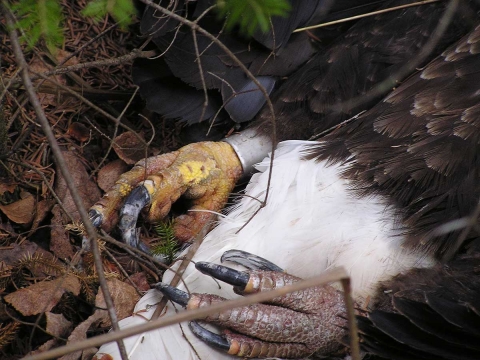Losing a family pet to old age, disease or trauma is never easy. The last thing you’re probably thinking about when you are managing your emotions at that moment is logistics. There are things you can do now, to prepare for that inevitably and make the process easier and safer. We at the U.S. Fish and Wildlife Service are asking you to learn a little about those logistics now, so you can potentially save wildlife from unintentional poisoning and death in the future.
What is secondary poisoning and how does it happen?
The same drugs that are used to help bring a quick and humane end of life for family pets and livestock linger after their use and can be lethal for scavenging wildlife and domestic animals. While euthanasia by sodium pentobarbital injection is recommended for many species by the American Veterinary Medical Association Panel on Euthanasia, this action requires follow-through on the part of your veterinarian to properly dispose of the animal once this drug is administered. As a client, it’s important that you have clear communications with your veterinarian early in your relationship, before you are faced with the need to use those services down the road. Even if unintentional, the practitioners who administer these drugs need to take extra care to avoid poisoning protected wildlife like eagles, hawks and ravens.
These secondary poisonings almost always are the result of improper disposal and are preventable. While veterinarians and other practitioners have long known of the inherent dangers when carcasses are left out in the open in fields or left exposed at landfills, they may not realize that it happens all across the country in both rural and urban geographies. Bald eagles, raptors and various mammals are protected by a collection of federal laws, ranging from the Migratory Bird Treaty Act and the Bald and Golden Eagle Protection Act to the Endangered Species Act, depending on the species. While other animals, including pets, may not be protected by federal law, it’s possible that people involved in such a poisoning incident would be open to civil liability under applicable state and local laws.
When an animal is euthanized by pentobarbital injection, the drug is quickly distributed throughout its body. When a scavenger feeds on the carcass, the degree of exposure to the drug will depend on the amount and type of tissue ingested. Some organs, like the liver, can have especially high concentrations of pentobarbital, and other tissues will also likely contain residues. A lethal dose for a bird would generally be much lower than the amount administered to euthanize the source animal. The ability of eagles to move quickly on a fresh carcass and then aggressively fend off other potential scavengers, coupled with their preference for internal organs, makes them particularly susceptible to secondary poisoning. Further, eagles may be more sensitive to the effects of the drug compared to other species, as raptors have a relatively narrow tolerance for barbiturates.
You can help stop poisoning in the future
If you are faced with the tough choice of euthanizing your family pet, please take preventive measures. Discuss what end of life services your veterinarian offers and ask about their disposal procedures. Clear communication is essential in preventing secondary poisonings and you can help make the difference. Your state extension service is also a good place to learn about the local laws and best practices. Here’s the guidance that we recommend for proper disposal.
Proper disposal
- Incineration or cremation, if available, is the preferred method of disposal
- Immediate deep burial will also prevent access by scavengers. Most regulations require at least three to four feet of cover. Beyond local statutory minimums, additional amounts or types of exclusionary cover may be required in certain habitat areas. This total coverage should always be defined by the ability of local scavenging wildlife to access buried carcasses.
- All burials should properly address the required distance above groundwater table, appropriate soil type and permitted locations for burial pits
- If frozen ground prevents immediate burial, the carcass must be covered or stored in such a way that access by animal scavengers is prevented. Some regulations specify that a wooden or metal lid designed to exclude scavengers may be used in burial pits that are not immediately covered over with the required amount of soil.
- Double bagging with heavy duty sacks and clear labeling of poison carcasses should be the minimum acceptable standard at every small animal veterinary clinic, humane shelter or animal control facility that sends out carcasses for third party disposal
- Local landfill regulations and management practices must be reviewed and revised if they currently afford easy access by scavengers to poisoned animal carcasses
The U.S. Fish and Wildlife Service is responsible for protecting America’s wildlife from poaching, illegal commercialization and other kinds of wildlife crime. While we work with federal, state and tribal conservation partners across the country to investigate these crimes, we also depend on proactive efforts from concerned citizens. Thank you for taking the time to learn about this issue and help us spread the word about secondary poisoning in your community.





